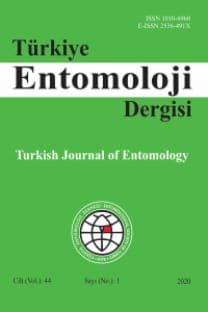Adult survival rate and oviposition preference of Stephanitis pyri (F., 1775) (Heteroptera: Tingidae) on different plant species
Farklı bitki türlerinde Stephanitis pyri (F., 1775) (Heteroptera: Tingidae)’ nin canlı kalma oranı ve yumurtlama tercihi
___
- Aysal, T. & M. Kivan, 2007. “Armut kaplanı, Stephanitis pyri (F.) (Heteroptera: Tingidae) üzerine bazı konukçu bitkilerin etkileri, 87”. In: II. Türkiye Bitki Koruma Kongresi (27-29 Ağustos 2007, Isparta) Bildirileri, 342 s.
- Aysal, T. & M. Kivan, 2008. Development and population growth of Stephanitis pyri (F.) (Heteroptera: Tingidae) at five temperatures. Journal of Pest Science, 81: 135-141.
- Buntin, G., S. K. Braman, D.A. Gilbertz & D.V. Philips, 1996. Chlorosis, photosynthesis, and transpiration of azalea leaves after azalea lace bug (Heteroptera: Tingidae) feeding injury. Journal of Economic Entomology, 89: 990-995.
- Drake, C. J. & F. A. Ruhoff, 1965. Lacebugs of the World, a Catalog (Hemiptera: Tingidae). Bulletin of United States National Museum Bulletin, 243: 1-643.
- Dhileepan, K., M. Trevino & L. Snow, 2006. Application to release the leaf-sucking bug Carvalhotingis visenda (Hemiptera: Tingidae), a potential biological control agent for cat’s claw creeper Macfadyena unguis-cati (Bignoniaceae). Queensland Government Natural Resources, Mines and Water. (Web page: http://www.saveourwaterwaysnow.com.au/_dbase_upl/carvalhotingis-visenda.pdf (Date accessed: Şubat 2010).
- Göksu, M. E., 1964. Sakarya ve Kocaeli Bölgeleri Meyve Ağaçlarinda Zarar Yapan Armut Kaplanı (Stephanitis pyri F.)’nın Biyolojisi ve Mücadelesi Üzerinde Araştırmalar. Göztepe Zirai Mücadele Enstitüsü Yayınları No: 160, Istanbul, 53 s.
- Gulpercin, N. & F. Önder, 1999. Bornova koşullarında Stephanitis pyri (F.) (Heteroptera: Tingidae)’nin biyolojisi ve dogal düşmanları üzerinde çalışmalar. Türkiye Entomoloji Dergisi, 23: 51-56.
- Janz, N., 2002. “Evolutionary of Oviposition Strategies, 349-376”. In: Chemoecology of Insect Eggs and Egg Deposition (Eds: M. Hilker & T. Meiners), Blackwell Publishing, Berlin, 390 pp.
- Lodos, N. 1982. Türkiye Entomolojisi II (Genel, Uygulamalı ve Faunistik). Ege Üniversitesi, Ziraat Fakültesi Yayınları No: 429, E. Ü. Ziraat Fakültesi Ofset Atölyesi, Bornova, İzmir, 591 s.
- Neal, Jr. J. W. & C. W. Schaefer, 2000. “Lace Bugs (Tingidae), 85-137”. In: Heteroptera of Economic Importance (Eds: C.W. Schaefer & A.R. Panizzi), CRC Press, New York, 828 pp.
- Önder, F., & N. Lodos, 1983. Preliminary List of Tingidae with Notes on Distribution and Importance of Species in Turkey. Ziraat Fakültesi Yayınları No: 449, E. Ü. Ziraat Fakültesi Ofset Atölyesi, Bornova, Izmir, 51 s. SPSS, 2006. 15.0 Edition for Windows.
- West, S. A., & J. P. Cunningham, 2002. A general model for host plant selection in phytophagous insects. Journal of Theoretical Biology, 214: 499-513.
- ISSN: 1010-6960
- Yayın Aralığı: 4
- Başlangıç: 1977
- Yayıncı: Galip KAŞKAVALCI
Mikdat DOĞANLAR, Erdal SERTKAYA, Marcela SKUHRAVÁ
Ümit İNCEKARA, Abdullah MART, Ahmet POLAT, Zeynep AYDOĞAN, Hicran TÜRKEN, Gani Erhan TAŞAR, Sinan BAYRAM
Özgür VARER IŞITAN, Nevran Eylem AKMAN GÜNDÜZ, Adem GÜLEL
Marcela SKUHRAVÁ, Mikdat DOĞANLAR, Erdal SERTKAYA
Murat KÜTÜK, Neslihan BAYRAK, Rüstem HAYAT
Vangölü havzası ceviz ağaçlarındaki böcek faunası
Remzi ATLIHAN, Mehmet Salih ÖZGÖKÇE, Mehmet Bora KAYDAN, İsmail KASAP, Neşet KILINÇER, Suat KIYAK, Evin POLAT AKKÖPRÜ
Şanlıurfa ilinde tarımsal ve doğal alanlarda nematod biyoçeşitliliği
Şenol YILDIZ, İbrahim Halil ELEKCİOĞLU
Abdullah YEŞİLOVA, Mehmet Salih ÖZGÖKÇE, Remzi ATLIHAN, İsmail KARACA, Fevzi ÖZGÖKÇE, Şükran YILDIZ, Yılmaz KAYA
Ümit İNCEKARA, Abdullah MART, Ahmet POLAT, Zeynep AYDOĞAN, Hicran TÜRKEN, Gani Erhan TAŞAR, Sinan BAYRAM
